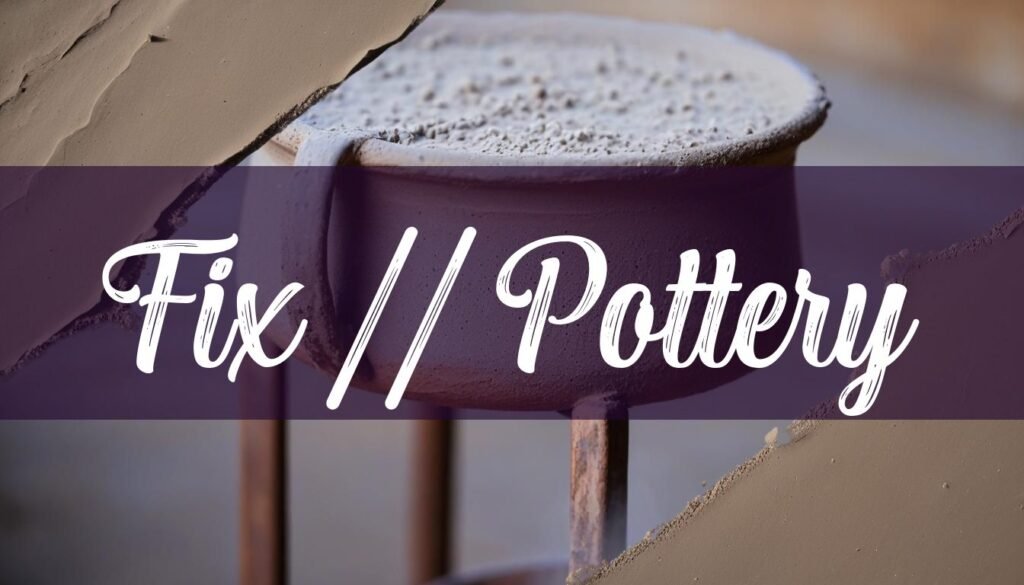Repairing broken pottery is a delicate art, blending practical skills with a touch of reverence for the object’s past. Whether it’s a cherished family heirloom, a piece of your own creation, or a lucky thrift store find, a broken piece of pottery doesn’t necessarily mean the end of its story. With the right techniques and adhesives, you can often restore these items to their former glory, or at least preserve them in a stable, aesthetically pleasing way. The key lies in understanding the different types of adhesives available, preparing the surfaces correctly, and providing adequate support during the curing process. Let’s explore how to mend your broken treasures.
Choosing the Right Adhesive
Selecting the appropriate adhesive is the first crucial step in repairing broken pottery. There’s a common misconception that all strong glues are created equal, but when it comes to ceramics, the choice between super glues and epoxies can make all the difference. Super glues, also known as cyanoacrylates, are single-component adhesives that harden rapidly upon exposure to moisture in the air. They form a strong, quick bond and work best on non-porous materials where pieces fit together tightly. However, super glues have low shear strength, meaning they don’t handle off-angle stress well, and they aren’t ideal for filling gaps. They also tend to yellow over time and aren’t suitable for repairs that might undergo further restoration work. For items that aren’t handled often and don’t require long-term durability, super glue might suffice, but for more substantial repairs, epoxy is generally the better choice.
Epoxies, on the other hand, consist of two parts – a resin and a hardener – that must be mixed together. They offer a strong, structural bond and excel at filling voids between parts. Mending epoxies are gap fillers, making them ideal for pieces that don’t have a perfect fit. Epoxies come with varying set and cure times, from quick-setting (5 minutes) to slower-setting options that can take several hours. Slower-setting epoxies are generally stronger, though some fast-setting epoxies have improved in strength. While some epoxies can be yellow or colored, clear epoxies are available, though they may yellow over time when exposed to UV light. High-end, non-yellowing clear epoxies are often used in professional ceramic and Kintsugi repair. Some epoxies can withstand high temperatures, up to 2000°F (900°C), making them suitable for pottery that might be exposed to heat. If you are interested in pottery conservation, see this guide to conserving ceramics. Also, if you plan to sell some of your repaired pottery, here is a guide to how to price handmade ceramics.
Surface Preparation and Alignment
Before applying any adhesive, proper preparation of the broken pottery surfaces is essential for a strong and lasting repair. Start by cleaning the broken pieces thoroughly with alcohol to remove any dust, dirt, or oils. This ensures proper bonding of the adhesive. For pieces that will come into contact with food or liquids, it’s best to use a water-resistant glue. A clear glue is also preferable to avoid unsightly marks.
Next, perform a “dry run” to ensure proper alignment of the broken pieces. This involves fitting the pieces together without glue to see how they align. For complex breaks, a “sandbox” filled with rice, sand, or PVC pebbles can be helpful to hold the larger piece in place while you align the other pieces. Once you’re satisfied with the alignment, apply the adhesive to both surfaces of the break and let it sit for a couple of minutes to become tacky. Then, carefully push the pieces together, attaching one piece at a time and allowing it to dry fully before moving on to the next. Quick-setting glues (less than 10 minutes) are recommended to minimize the need to hold the pieces together for extended periods.
Clamping, Curing, and Finishing
Ensuring proper adhesion and alignment during the curing process is crucial for a successful repair. Holding the pieces by hand isn’t practical, so it’s important to employ methods to secure the pieces in place until the epoxy cures sufficiently. In many cases, a container with PVC pellets, rice, or sand can be used to hold broken segments in place, using gravity to position the pieces where no temporary bonding is required. If you’re unsure whether the pieces will stay in place, tape or clay can be used to keep the parts matched until the epoxy cures. A glue gun is another option, although it can be a bit harder to remove the adhesive once the epoxy cures. For heavy and large items, ropes and winches can be used.
Once the adhesive has fully cured, carefully remove any excess adhesive with a sharp blade or solvent. For a seamless repair, you can use fillers and paints to conceal the repair line. However, it’s important to note that poorly executed or aggressive restorations can diminish the value of the piece. Finally, hand wash the repaired pottery to remove any stray glue or residue.
Maintaining and Cleaning Repaired Pottery
To prolong the life of the repair, it’s important to clean and maintain the pottery properly. After you have got the pottery as clean as you can, wash the vase with soap and warm water. Afterwards, soak your art pottery in tap water until the vinegar smell is gone. For fine porcelain cups, brushes with cotton ball tips are useful to clean safely with less pressure. White vinegar (distilled vinegar) can be used to help with lime deposits, by soaking the pottery for a few hours in a 50/50 solution of white vinegar and filtered water, then scrubbing with a non-abrasive brush. If lime is still stubborn after the vinegar soak, try rubbing with baking soda and vinegar together, but always follow with a 50/50 white vinegar wash to balance the pH and remove any residual baking soda. Another option is citric acid and baking soda, which is recommended by Zojirushi for cleaning scale from their water boilers.
However, it’s important to avoid cleaning repaired items using aggressive methods, as any existing repairs may be compromised or damaged during the cleaning process. Constant wetness will eventually fatigue the epoxy, so drying the pottery after each use will preserve the repair for longer.
Common Mistakes to Avoid
Several common mistakes can undermine the success of your pottery repair. Using super glues for repairs that require strength and durability is a frequent error. Failing to prepare the surfaces properly by not cleaning them thoroughly can also lead to a weak bond. Additionally, using adhesives that are not sandable or paintable can make it difficult to conceal the repair line.
Humidity and heat can cause permanent discolorations, and prolonged exposure to UV light can cause epoxies and fillers to yellow over time. Epoxies, fillers, and cold glaze can start to fail at high temperatures (180-200°F), causing cemented parts to shift. Finally, rushing the drying or firing process can lead to cracking. By avoiding these common mistakes, you can increase your chances of a successful and long-lasting pottery repair.





